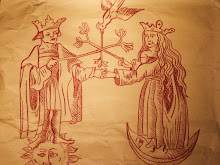In the dim light of the Toy Theater Museum as the hour approaches midnight, the peachy-toned drapes of the gazebo display the silhouettes of figures darting to and fro in the midst of performing their miniature shows, and the air is filled with the sounds of instruments being plucked, voices being raised, protagonists dying agonising deaths and jesters cackling. Beneath these sounds, and the regular rounds of applause as each little show reaches its conclusion, my ears pick out the soft, mournful tones of a falsetto singer that can surely only be that of melancholic musical outfit Anthony and the Johnsons. Following the melody I pass through the crowds and eventually find the toy theatre piece which I am placing under my second category of New Toy Theatre - Romantic Toy Theatre.

Here I find a truly shrine-like toy theatre, sumptuously furnished with gold ornamentation and based around an elegant proscenium arch frame. Tanya Khordoc and Barry Weil of puppetry company Evolve are dressed in vintage threads with faces encapsulating the sensitive melancholy of the song which plays around them as they manipulate two-dimensional panels of scenery and figures in silent communion with the music. Imagery is Victorian, figures are etched in black and white and scenery is lush and bedecked with satin and sequins. Two faces steal a mournful kiss before being separated. Two lovers dance around each other briefly, then part. Boxes, doors and chests close, sealing within them, we suspect, secrets and tears.
This, I call the New Romantic Toy Theatre. A new form of animation which is delicately manipulated by hand, in the present moment, as opposed to the refined programming of a computer. A simple moving-around of flat images to create metaphors which last for a few seconds but speak volumes. A softly-spoken, understated collection of visual messages which work with a piece of music to unravel stories buried within it, allowing the ear to work with the eye simultaneously to bring emotions alive.
There weren't many toy theatre pieces at the festival which completely lacked the spoken word, but often those which verbally said the least managed most effectively to harness the simple power of the visual.







































